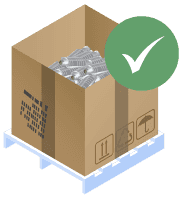Catalytic Converter Price
How Much is a Catalytic Converter Worth?

This is the number one question in the industry, and it has both a simple and complicated answer. Catalytic converter value depends heavily on industry standards, environmental laws, and the ever-changing life of an automobile.
And in truth, there is no standard method to find the value. This article will break down the most important factors involved in the industry’s biggest mystery: “How much is a catalytic converter worth?”
The Big Three
The value of catalytic converters depends on what we call “the big three”. It’s important to have extensive knowledge of these factors in order to buy converters competitively while turning a profit.
Concentration of precious metals
When converters are made, their cores are loaded with precious metals—platinum, palladium, and rhodium. The loadings follow an environmental standard that varies according to the country or state where a vehicle will be sold.
The process for loading converters with precious metals leaves room for variation. Not every country or state has the same legislation for how much precious metal needs to be loaded into a converter in order to be legally sold there.
Simply put, how much a converter is worth varies right from the start.
Environmental standards
Catalytic converter value also depends heavily on environmental regulations, so it’s important to be aware of the origin of the converter you’re purchasing.
Emission laws were enacted to reduce harmful gas emissions, and converter value varies according to these laws. California has higher and stricter environmental standards, so it’s safe to say that a converter built and put in a vehicle sold in California will have more precious metal loadings. A converter from Texas will have a lower value because emission laws in Texas are not as strict.
That means that if a company only has data on California converters, a unit from Texas would be overvalued. If you’re sourcing converters from different jurisdictions, make sure you know each converter’s origin and the related legislation.
Lifecycle
Every converter will lead a different life regardless of where it was originally sold.
Cars go through a rough life. They drive down muddy roads, brave winter storms, and spend their lives around street dust. Because of a vehicle’s hard-knock life, the precious metal concentration in a converter will be depleted with use. It’s hard to give an exact amount, but it’s fair to say that a unit could lose between 5% to 20% of its original recycled value during a vehicle’s lifespan.
Additionally, if the same type of converter enters the recycling stream after 50,000 miles, it will have a higher value than one that enters at 500,000 miles.
How can you determine catalytic converter worth then?
To do so, all of the above factors must be taken into consideration. You must also consider the current precious metal market and the market where you will sell the unit, along with profit margin. Some converter processors provide guides to determine converter value, but the most important thing to have is knowledge.
Price lists & apps
While converter recycling companies often have guides to price converters, these guides can only provide ballpark estimates for individual units, not the actual value of every end-of-life catalytic converter.
It’s important to understand that any price sheet or app price is derived from the laboratory analysis of individual units. That means that any price you are given is an estimate coming from precious metal loadings that were present in units that have been analyzed – not the unit you hold in your hand.
Single unit sale
In the case of a single unit being sold, it may be beneficial for the seller to have access to a robust database and sell the units in bulk to a converter refiner or toll-refiner. Most importantly for any catalytic converter transaction, both the buyer and seller should have a good understanding of what factors are going into the unit’s price.
The Bottom Line
The value of a catalytic converter is subject to many factors: the concentration of precious metals, environmental guidelines, and a vehicle’s lifecycle. And all those factors have their own ifs and buts.
Working with a trusted toll-refiner is your best bet. Make sure your processor gives you access to a serial number catalog, a price list & app, and keeps you constantly updated with industry knowledge. That’s your best shot at getting the accurate value for your material.
Learn more about why this is important by reading the difference between price lists and serial number catalogs.
Did you enjoy this article on converter data and statistics? Visit PMR’s Resource Center to learn more.

